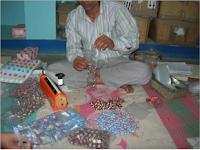 Varanasi is situated at the bank of river Ganges, one of the oldest city and is prominent on the tourist map of the world. It is cultural and industrial Centre in U.P. Due to heavy influx of tourist, small industries based on hand skills developed during the course of time. Among others Glass Beads and imitation jewellery made in Varanasi became famous.
Varanasi is situated at the bank of river Ganges, one of the oldest city and is prominent on the tourist map of the world. It is cultural and industrial Centre in U.P. Due to heavy influx of tourist, small industries based on hand skills developed during the course of time. Among others Glass Beads and imitation jewellery made in Varanasi became famous. 
 The glass beads have a history of around 100 years. Earlier few artisans used to import raw glass and tubes from Firozabad and other places and used to manufacture beads for catering the demand of the tourist visiting Varanasi. With the increased in demand manufacturing activities increased and reached the rural areas of Varanasi. Presently the activities have spread to 40-50 villages in Varanasi and areas around and presently around twenty thousand workers are engaged in these industries. Numbers of micro and artisan based, processing and medium/ small scale unit are working in Varanasi.
The glass beads have a history of around 100 years. Earlier few artisans used to import raw glass and tubes from Firozabad and other places and used to manufacture beads for catering the demand of the tourist visiting Varanasi. With the increased in demand manufacturing activities increased and reached the rural areas of Varanasi. Presently the activities have spread to 40-50 villages in Varanasi and areas around and presently around twenty thousand workers are engaged in these industries. Numbers of micro and artisan based, processing and medium/ small scale unit are working in Varanasi.Following items manufactured by artisans at Varanasi.
Solid glass beads - these glass beads are largely used in preparation of artistic show pieces and ornaments
Fancy beads – these are mainly used in India
Hollow beads used for ornaments, wall hanging, curtains and other items.
Glass beads manufactured are generally made by use of colour block glass, glass rod and tubes. The artisan’s units, engaged in production, comprise of hand tools, addas, burner and few other equipments costing 20,000 to 25,000 rupees. The dies which give shape to the beads are generally prepared as per design of the company placing orders for manufacturing of these items. The fuel used is kerosene oil which is generally taken by these artisans from open market. Block glass, rod and glass tubes are main raw material which are purchased form the open market or supplied by the firm placing orders to these artisans, who are the traders and have extended their operation to exports and entered in the field of manufacturing of raw material viz, glass rod, tubes in their own glass factories and have developed arrangements through contractors to ensure distribution of raw material among the artisans and recollections as finial product.
At present approx. 20,000 artisans are engaged in manufacturing of glass beads and some 35,000 to 45,000 people in other allied activities in Varanasi. Approximately 8,000 micro units are engaged in production of beads, with 50 small and 6 big units in this area, important among them is M/S Banaras Beads Ltd. The total production volume of the area in terms of rupee is around 105 crores out of which some 70 % is exported to various countries fetching a valuable foreign exchange worth Rs.70 to Rs.72 crores per annum. The perfect and natural mix of urban and rural artisans is the most important factor of this sector. Beside Varanasi Firozabad and Purdilnagar are the other centres where glass bead manufacturing is carried on.
The stress is now for quality up-gradation with improvement in technology, upgraded process and improved raw material. Varanasi is on proposed route of gas pipe line to be laid by ONGC. The availability of gas towards raw material will result in reduction of manufacturing cost. In spite of threats from china, the industry has witnessed growth rate of 10-12% in the last few years. Large number of artisans and SME has survived in this sector.
S.K. Singh
Udyog Bandhu


